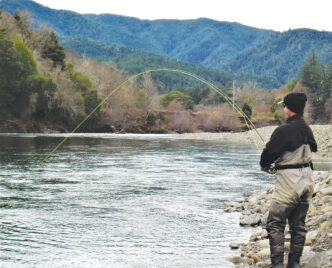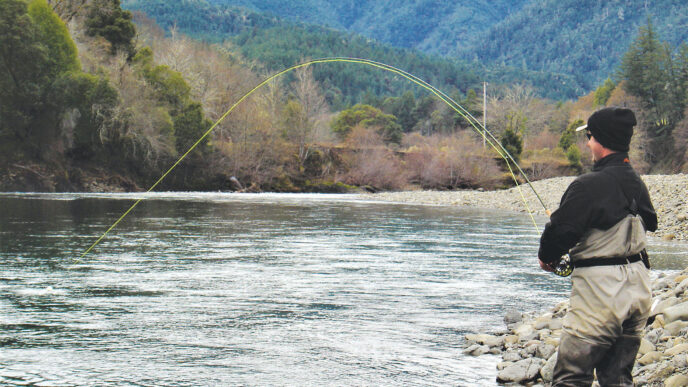Twenty-five years ago I began working in the fly-fishing retail business, helping anglers with their questions about equipment and technique. It was in the spring, just as it is now, and as you read these words, the shad are swimming up the Sacramento and other rivers to spawn, just as they have since the late nineteenth century.
The introduction of shad in the West began in June of 1871 with twelve thousand fry from the Hudson River stored in milk cans on a train departing from New York. Forty tons of coal-powered locomotive chugged westward, puffing steam and belching smoke across prairies and through valleys and mountain passes until finally stopping in the Sacramento Valley. The young fish were released into the Sacramento River near the town of Tehama. A second shipment in 1873 screeched and whistled along more than twenty-eight hundred miles of tracks, jostling some thirty thousand more fingerlings in a specially designed aquarium box car. They arrived in July and also were released into the Sacramento River, as were subsequent shipments. Around eight hundred thousand fingerlings had been sent to California by the end of 1880. As was the case with another nonnative sport fish, striped bass, shad were transplanted from the East Coast in an effort to replace dwindling fish populations in the San Francisco Bay Area. The shortage was caused by overharvesting of native fish brought on by the hunger of thousands of fortune seekers lured by the discovery of gold and the acquisition of cheap land.
Fast forward to the late 1980s, when I started fishing for shad and working in fly shops. Our standard shad setup consisted of a 7-weight rod, a simple click-and-pawl-drag reel, several 30-foot shooting heads of varying sink rates, 20-pound fluorescent Maxima for the running line, five feet of 6 to 8-pound mono for a leader, and a handful of colorful, alien-looking shad flies. The shop salesman would instruct you to pick an evening and drive to such and such location on the river, look for the lineup of fly flingers, squeeze your way in, and start casting. Mend your line upstream and let it swing . . . oh, and give the fly some twitches — very simple.
I occasionally caught fish — mostly, I didn’t. However, it wasn’t too long before I noticed that a few anglers in the line were almost always hooking up while I was merely watching and wishing that one of those big silvery herrings would accidentally eat my fly. And over the years, as a result of time spent on — and in — the water, my success rate improved.
Times and technologies change, and today, there are many options available concerning choice of tackle, lines, flies, and presentations to the fly fisher who’s beginning to target shad. The staff of today’s fly shops will be happy to clue you in. Here, instead, I want to share what I learned that is timeless — how shad navigate a river. Because you can’t catch shad if you can’t find them, and the rivers that shad travel are big.
Knowledge Is Power
Knowledge of fish habits will increase any angler’s success. While attending college in the 1980s, I inadvertently learned about shad and their idiosyncrasies while swimming and snorkeling the American River. Several times a week, I salvaged sunglasses off the river bottom and sold them in a downtown Sacramento coffee shop, priced according to how much they were scratched. While holding my breath and drifting in the current (instead of studying for a logic test), hovering above the river bottom, I observed schools of shad. I noticed that shad prefer certain depth positions as they face into the current, and I noticed that this preference changes with the time of the day.
Returning to fresh water from the ocean to spawn, shad navigate currents that speed up here, slow down there, and speed up again along the undulating ground that forms the riverbed, with its tailouts, riffles, and runs. And unlike salmon, shad do not have to die after spawning, so they need to conserve energy for the trip back. As a consequence of all this, they always choose a route of least resistance in heavy currents. They need places to rest and for protection from predators, especially when the sun is high overhead.

If you were a shad seeking a place to rest and protection from predators in the long middle of the day, with the bright sun shining down on the water, would you feel safer holding in a shallow, fast-moving, brightly lit tailout, in the deeper riffle, or in the even deeper, slower moving run where the sun penetrates the least? The correct answer is obvious — the run. The riffle would be your second choice, because it has some depth and larger river rocks, creating eddies for resting and a choppy surface diffusing the sunlight. Also, the riffle will often have a current break at a bend in the river where slower water slides along beside faster water — a seam. Seams create areas where shad can conserve energy by avoiding heavy current. The seams steer the fish, creating a route. Discover that path, and you will catch fish. Runs are best fished from a boat, but riffles are the best areas for wading.
The bottom contour of a riffle sloping down into a run and then back up into the next riffle can be described as a bowl between two tailouts. Schools of shad will stack up in that refuge like Lucky Charms in a bowl of milk. Reluctant to enter shallow water when the sun is bright, they will circulate back and forth from one end to the other. It is there that you will consistently catch fish throughout the day.
Over the years, I have been entertained while standing in a lineup of shad anglers to watch how the one farthest downstream will begin catching fish, then everyone starts hooking up as the school of shad moves upstream in the bowl. If it is a longish riffle and run, the fish can turn around at the shallowing top and head back the other way, continuing to be caught until vanishing into the deep run, safe from the wading angler. It can be quite a while before catching resumes. If the bowl is short, the fish may tire of the harassment and shoot up through the tailout and down into the next bowl.

As the day turns into evening, sunlight no longer deeply penetrates the river. The shad feel comfortable, become more active, and rise from the bottom. They begin swimming closer to the surface. Sometimes they may break the surface as they feed on caddisflies. The shad will even move into the shallower riffles they had shunned during the bright hours. This is one of their favorite times to swim upriver and through the very shallow tailouts. This behavior can also occur on overcast days.
During periods of subdued light, I’ve found shallow fly presentations very useful. One evening, for instance, I was fishing a favorite riffle with my friend, Jeff Ching. I was fishing shallow while Jeff was swinging deeper. He was landing one fish after another; I was catching nothing. ”Change your line,” Jeff told me. “No,” I replied. “Give me fifteen more minutes for the sun to drop behind the trees.” Sure enough, as the sun descended, the shad moved shallower and I hooked a fish with every cast. Jeff’s hook rate dropped to zero. He was fishing too deep.
The Top and Bottom Line
There are fly fishers who will tell you that shad fishing is easy: shad will strike just about anything. But that most often occurs during the evening, the witching hour. That’s when the crowd of anglers is standing shoulder to shoulder. When the sun is no longer high overhead, cast out your fly and let it swing. Hang on. It’s all good. But what do you do the rest of the time — when you can’t just fish the witching hour, and when the fish are playing hard to get all day long? The key to shad fishing is finding them. If you know how shad move through the river, you can hook them — even at high noon. Here’re the simple rules for shad success: always look for the path of least resistance, pay attention to the sun’s position in the sky, and when the sun is low to the horizon or behind clouds, sometimes go shallow, and when the light is bright, go deep.
















